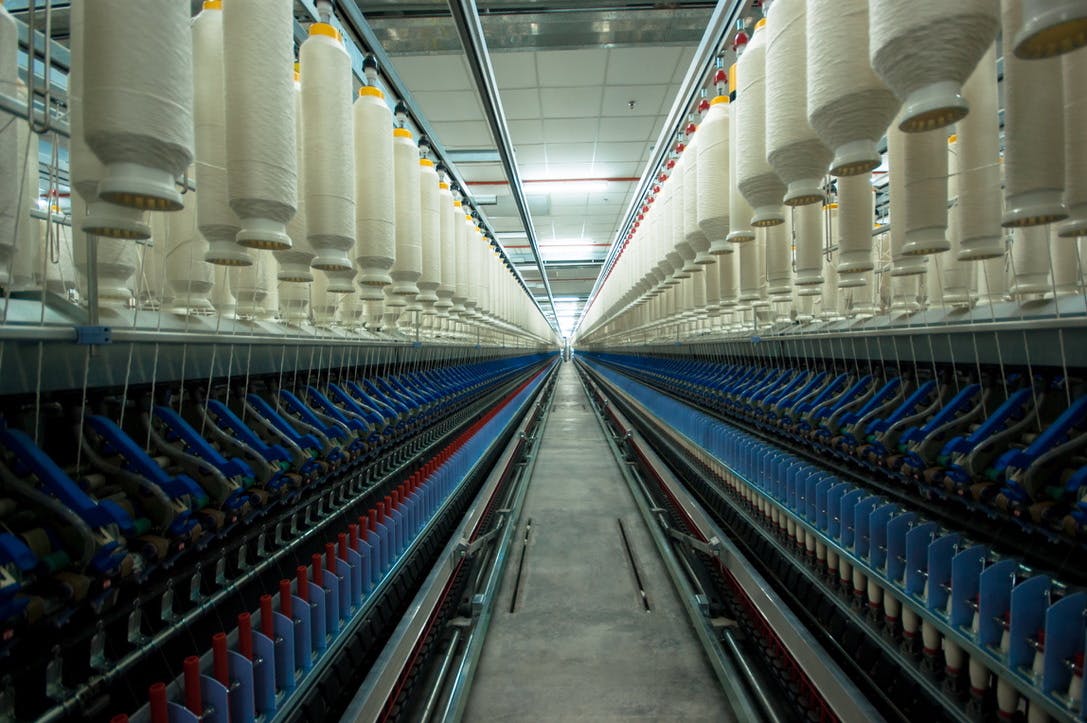It is a largely invisible problem, but microfibre shedding is a growing source of pollution that poses a potential threat to marine creatures and humans.
Millions of short textile fibres are shed with each laundry load. Many washing machines and wastewater treatment systems are unable to adequately filter these fibres that are up to five millimetres long, causing them to leak into waterways and oceans.
Although studies have shown how consumers can reduce the shedding leakage of microfibres—washing clothes at lower temperatures and full loads, and using nylon bags to trap the fibres, for instance—efforts to tackle the challenge at the production stage are only just emerging.
What can textile and clothing manufacturers do to minimise microfibre shedding?

Some textile manufacturing processes could have an impact on microfibre shedding. Image: Ramatex
Together with international sustainability non-profit Forum for the Future and technical advisor Nicole van der Elst Desai, Singapore-headquartered apparel manufacturer Ramatex is on a quest for answers.
It wants to find out what opportunities lie at various stages of the manufacturing and design process, from fabric production to wastewater treatment.
Under the Circular Leap Asia (CLA) programme—a two-year innovation programme that aims to help apparel manufacturers, brands and retailers in Asia develop and scale circular solutions—Ramatex sought to identify research it could do to understand the impact of selected textile manufacturing processes on microfibre shedding.
As a vertically integrated manufacturer, Ramatex is able to directly control processes such as fabric production, yarn spinning and fibre processing, said Karen Sim, senior strategist at Forum for the Future. “Ramatex is also able to work on solutions with brand customers, such as sportwear companies, that it has established relationships with. This makes it possible for the company to experiment with a greater range of circular-economy solutions,” she said.
“Circularity is an area where, as manufacturers, we can take the lead to figure out sustainable pathways with brands,” said Keith Ma, strategic director of Ramatex Group. “We are familiar with eliminating microfibre release to the environment using our water treatment systems. Currently, we do this from a factory health and pollution standpoint. But there is the opportunity to apply these relevant skills to fabric and garment design and manufacturing processes, with the aim to reduce microfibre shedding from final products.”
Eco-Business spoke to van der Elst Desai, a textile innovation and sustainability consultant with 20 years’ experience across various parts of the fashion supply chain, to find out why more research is badly needed.
Why is microfibre shedding a problem?
Microfibres are getting into our waterways, in the guts of the fish that we eat and the water that we drink. Scientists have found it present in the human body; we just don’t know how much of a human health hazard it is.

Synthetic fibres like polyester are widely used in athleisure wear. But microfibre shedding happens in all fibres, including cotton. Image: Dylan Gillis/ Unsplash
Polyester is the main material used in athleisure and sportswear. With the athleisure business booming, can we really reduce microfibre shedding?
It is not as simple as saying the athleisure and sportswear industry is responsible. The fashion industry, in general, uses a lot of synthetics and polyester is used as it is relatively cheap and widely available.
Textile microfibre shedding happens in all fibres. Recent research found denim present in the Arctic. Even though denim is made of cotton, the study noted that “accumulation in natural environments could pose risks to animal and plant life as [the garments] are treated with chemical processes”.
Recent research shows that 35 per cent of microfibres found in the ocean are from textiles; 79.5 per cent of them are from cellulosic fibres and 8.2 per cent are synthetic.
This provides much needed evidence that will hopefully change the perception that natural fibres like cotton are less ocean-polluting than synthetic fibres such as polyester. To me it is really important to find solutions that can reduce or mitigate the microfibre shedding of textiles. Understanding how textile microfibre shedding occurs in manufacturing for all fibres will contribute to finding solutions to do so.
What do we currently know about ways to reduce microfibre shedding? Have there been efforts by designers and manufacturers?
There are both knowns as well as unknowns. The creation of textiles involves many processes. Textile microfibre shedding is very complex and requires a multi-stakeholder approach to understand the causes and, therefore, ways to reduce or avoid it.
Let’s start with what we know. We know that lots of textile microfibre shedding occurs when a consumer washes a garment. Most of the shedding will be captured by wastewater systems, some will leak into our waterways. You can use a little nylon bag that acts as a filter or use a washing machine that has a good working filter to capture the fibres. In both cases, it is important to clean these filters and throw any debris and microfibres into the bin.
What we don’t know yet is how to solve textile microfibre shedding. We don’t know much about what causes textiles to deteriorate, and fibres to fragment and be released. When you look more closely at the production of textiles and apparel, there are many points that warrant further research.
In the fashion industry, two larger groups that are involved in research are the Microfibre Consortium in the European Union and the Microfiber Partnership in Canada.
In Asia, there are some initiatives now on microfibres but things are nascent. What we are trying to do with the CLA programme is very important in building up understanding of the source of textile microfibre shedding in the region, where most of the manufacturing takes place.
What was the CLA project with Ramatex about, and what did it achieve?
Circularity in fashion is achieved through addressing all aspects of the industry—what the products are made of, how they are designed and sold but, most importantly, knowing how the products are made.
I’ve been in the fashion industry for 20 years, both with fashion manufacturers and large brands as well as the chemical industry. As Forum for the Future’s technical partner on the programme, I advised on the technical aspects of textile and apparel manufacturing from a technological, innovation and sustainability perspective.
For the CLA project with Ramatex, we have scoped research with a clear objective to reduce textile microfibre shedding through innovations in textile design and manufacturing processes. We are looking forward to starting the research this year.
Tell us more about the next steps.
We want to quantify how much shedding there is, and classify which materials the microfibres come from. This will help us to identify the areas in textile manufacturing that have the most impact on microfibre fragmentation and release.
We’re looking at optimised ways of testing, following industry practices where possible, that will give us the highest accuracy rate.
We also know that reducing washing temperatures will result in less shedding. In the manufacturing process, there is a lot of heat applied so if we play around with the amount of heat used, there may be potential to mitigate shedding, which could be an intermediate solution.
What are the key challenges apparel manufacturers face, and what can incentivise industry players to do more to minimise microfibre shedding?
Any systemic change always needs a combination of consumer demand, government action and industry willingness.
This is the fashion industry’s moment to take a proactive rather than a reactive approach. The research will provide answers and data, and tell us where action is most needed to reduce or mitigate textile microfibre shedding.
The fashion industry can make transformational changes through equal partnerships among various players.
We are not where we used to be, but we are not where we need to be either. When I started out, there was a lot of focus on the social aspects of the fashion industry—child labour and the working hours of employees. Then environmental groups started pulling samples from wastewater streams, which led to standards for zero discharge of hazardous chemicals.
While the industry needs to take responsibility, sometimes, finding solutions requires research. You need to know the extent of the problem, where it’s coming from, how it happens.
I am excited about the future. I think there are a lot of wheels in motion and, among partners of CLA, the willingness to do the right thing.
Find out more about circular fashion and the CLA programme in the report, Making the Leap to Circular Fashion.












